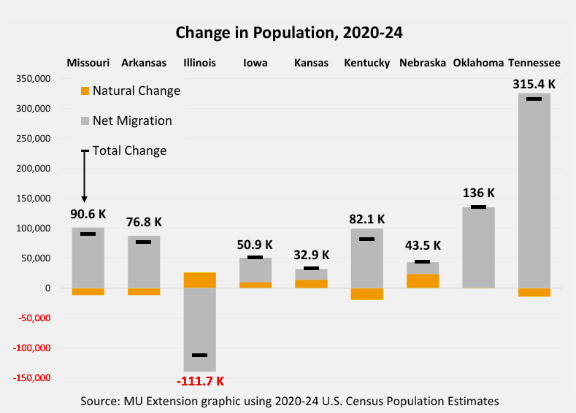JEFFERSON CITY – The latest Missouri Economy Indicators brief highlights the state’s population trends.
Missouri’s 2024 population of 6.25 million makes it the 19th most populous state in the U.S. Between 2020 and 2024, the state added over 90,000 residents—a 1.5% increase.
Metro counties experienced a 1.6% growth rate, while non-metro counties grew by 1.1%. The population growth was driven entirely by migration, with 101,152 new residents arriving from other domestic or international locations.
During the same period, the state saw a natural population decline (births minus deaths) of more than 11,000 people.
According to the 2020 decennial census, Missouri had a population of 6,154,744, ranking it the 19th largest U.S. state.
By 2024, that number had grown to 6,245,466—a 1.5% increase. While this growth is a positive trend, it masks important underlying dynamics. To fully understand population change, two key components must be considered: natural change and net migration (see sidebar for definitions).
Between 2020 and 2024, 40% of U.S. states (including Missouri) experienced a natural decrease in population. Missouri ranked 39th in natural change, with 11,261 more deaths than births, a trend partly driven by the COVID-19 pandemic. Missouri mitigated this natural decrease and ranked 20th in net migration by gaining 101,152 more residents.
Among Missouri’s border states, only Iowa, Kansas, Nebraska and Oklahoma saw both a natural increase and positive net migration. Notably, Tennessee experienced the largest total population gain, despite a natural decrease. On a national level, Florida had the highest net migration (adding more than 1.9 million new migrants) but ranked last in natural change, with 102,012 more deaths than births. As the chart illustrates, natural change and net migration can move in opposite directions, reinforcing the need to examine both components to understand population dynamics. Together, they offer a comprehensive look at the forces impacting population change.

Post-Pandemic Population Dynamics
Before COVID-19 (2010-19), 57% of Missouri’s counties experienced a natural increase in population.
During this period, Missouri’s metro areas saw natural growth of 2.1%, compared to 0.4% for nonmetro areas. Of the 51 counties experiencing a natural decrease during this time, 86% were nonmetro.
Between 2020 and 2024, COVID-19 contributed to a natural decrease in Missouri, with an excess of 11,261 deaths over births, resulting in a population decrease of -0.2%. Nonmetro counties experienced a 1.3% decline, mitigated somewhat by a small natural increase in metro counties (0.2%).
Over the past four years, only 21% of Missouri counties saw a natural increase. Missouri mirrors national trends. In 2024, 66% of U.S. counties experienced a natural decrease, up from 46% in 2019, but down from the 2021 peak of 73%. Between 2020 and 2024, 82% of Missouri counties experienced positive net migration, up from 74% in the previous decade. Missouri gained 101,152 new residents between 2020 and 2024—58% through international migration and 42% from domestic migration. During this period, the state ranked 28th in international migration and 17th in domestic migration. Taking both natural change and net migration into account, Missouri ranked 19th nationally in population growth, matching its rank as the 19th largest state by population.

All Missouri Economy Indicators briefs in this series are available at http://muext.us/MissouriEconomyIndicators
Sign up for the Exceed newsletter at http://muext.us/MUExceedNewsletter
Authors: Luke Dietterle, Extension Specialist, luke.dietterle@missouri.edu
